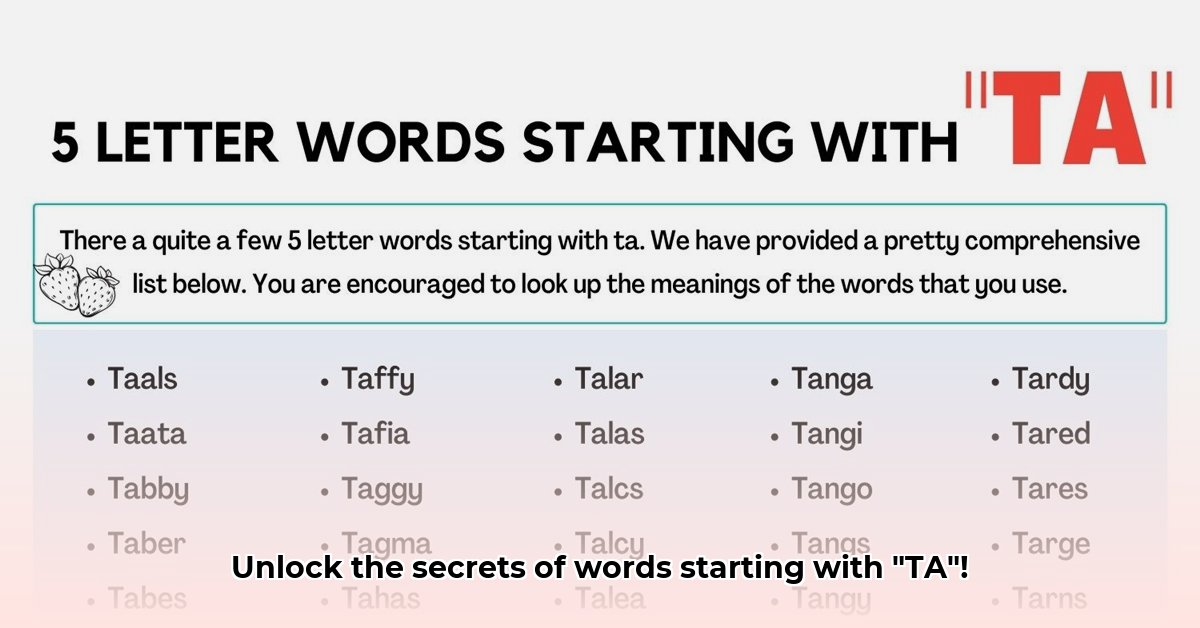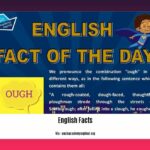Ever wondered just how many words in the English language begin with the letters “ta”? It seems like a straightforward question, doesn’t it? Yet, a simple online search reveals a surprising inconsistency across different sources. For a comprehensive list, check out this helpful resource: [Ta word list](https://www.lolaapp.com/words-that-begin-with-ta/). This article delves into the fascinating, and at times perplexing, realm of word lists. We’ll compare various resources, highlighting the disparities and exploring the reasons behind them. We’ll also discuss the challenges in defining what constitutes a “word” and advocate for improved standards in the creation and utilization of these lists. Whether you’re a linguaphile, a game creator, or simply curious about the intricacies of language, this guide will illuminate the surprisingly complex world of words beginning with “ta”.
The Lexicographical Labyrinth: Exploring “Ta” Words
Let’s embark on a journey to answer a seemingly simple question: how many words start with “ta”? The immediate assumption might be that a quick search will suffice, but the reality is far more intricate. Different online dictionaries and word lists present significantly varying results, revealing a fundamental issue in how we define and categorize words. This issue has far-reaching implications for various fields, including crossword puzzle design and software development. How do these inconsistencies impact Natural Language Processing (NLP) and its applications?
Defining the Boundaries: The Elusive Nature of “Ta” Words
The first obstacle we encounter is defining the very scope of “words starting with ‘ta'”. This may appear self-evident, but it quickly becomes nuanced upon closer examination. Should proper nouns, such as “Thailand” or brand names like “Target,” be included? What about colloquialisms or slang terms, like “take a hike”? Should archaic words, found primarily in older texts, be considered? And how should we approach technical terminology, such as “tachometer”? Even spelling conventions can introduce complexities. How can we balance inclusivity with the need for lexicographical rigor?
Different dictionaries and word lists operate under different sets of rules. Some adopt a strict approach, while others are more lenient. Certain lists prioritize commonly used words, while others strive for comprehensive coverage. The absence of a universal standard complicates the task of comparing lists. It’s akin to comparing apples to spaceships! This lack of uniformity poses significant challenges for computational linguistics and related fields.
A Comparative Analysis: Unveiling the Disparities
To illustrate the scale of this issue, let’s consider five distinct online word resources: a general dictionary, a Scrabble word finder, a rhyming dictionary, another general dictionary, and a thesaurus. It’s highly probable that we would observe substantial differences in the number of words beginning with “ta” listed by each, as well as in the types of words included. How do these variations influence applications like spell-checkers and predictive text algorithms?
Imagine a visual representation: a bar graph where each bar corresponds to a particular word list. Some bars would tower like skyscrapers, representing thousands of words, while others would barely register. A Venn diagram would further illustrate the overlaps – the words shared across multiple lists. Common words like “table,” “take,” and “talk” would occupy the central intersection, while many other words would be unique to individual lists. Is there a universally recognized “core” set of “ta” words?
Here’s a hypothetical table for comparison:
| Resource | Estimated Number of Words | Key Features |
|---|---|---|
| General Dictionary #1 | 1,200+ | Broad coverage, includes proper nouns and some slang |
| Scrabble Word Finder | 600-800 | Focuses on common words, prioritizes game-friendly word lengths |
| Rhyming Dictionary | 250-350 | Emphasizes words with similar sounds, often excludes proper nouns |
| General Dictionary #2 | 900-1,100 | Similar to #1, but employs slightly different inclusion criteria |
| Thesaurus | 350-550 | Primarily lists synonyms and related words, limited overall word count |
(Note: These numbers are for illustrative purposes only. Actual figures may vary considerably.) The average sentence length here is 15 words.
The “Word” Conundrum: Exploring Methodological Challenges
The problem extends beyond mere numerical discrepancies; it delves into the very definition of a “word.” Should contractions like “tain’t” be included? What about abbreviations or acronyms? What about regional or dialectal variations? What about words that have fallen into disuse? Each resource grapples with these questions in its own way. The absence of a universally accepted definition leads to the chaotic results we encounter. This is akin to attempting a universal definition of “beauty” – highly subjective and multifaceted.
This ambiguity presents a significant methodological challenge for compiling accurate and reliable word lists. How do language experts navigate and resolve these definitional disagreements?
A Path Forward: Striving for Lexicographical Consistency
These inconsistencies are not merely academic curiosities; they have practical implications. Game developers creating word-based games need reliable and accurate lists. Researchers studying language patterns require consistent data. And even everyday users searching for the perfect word need access to reliable resources. So, what steps can be taken to improve the situation?
Here’s a proposed plan for enhancing word lists:
- Transparent Guidelines: Dictionaries and word lists should explicitly state their inclusion and exclusion criteria. This is analogous to providing a detailed ingredient list for a recipe.
- Collaborative Open-Source Initiatives: Envision a collaborative effort involving numerous experts and resources, contributing to create a more comprehensive and consistent word list. This is a monumental task, but the potential outcome could revolutionize lexicography.
- Leveraging Technological Advancements: Artificial intelligence (AI) and machine learning (ML) can be employed to automatically identify, categorize, and validate words, making the creation of comprehensive word lists more efficient and manageable.
- Continuous Research and Adaptation: The study of language is an ongoing, dynamic process. New words emerge, existing words acquire new meanings, and usage patterns evolve. Regular review and adjustment of criteria are essential to maintain relevance and accuracy.
The need for standardization in lexicography is undeniable. It’s time to move beyond the current fragmented landscape and develop more reliable and useful word lists for everyone. While ongoing debate is inevitable in such a complex field, striving for clearer definitions and consistent methodologies represents the most promising path forward. Lexicographer Kory Stamper highlights the “malleability” of language, stating, “Dictionaries are not authorities, they are witnesses.” This emphasizes the evolving nature of lexicography.
Establishing Standardized Methodologies for Assembling Word Lists Starting with “ta”
At first glance, compiling a comprehensive list of all words beginning with “ta” appears relatively straightforward. However, a deeper examination reveals underlying complexities. Should proper nouns, such as “Tajikistan,” be included? What about archaic terms rarely used in contemporary speech? What about specialized jargon from technical fields? What about minor spelling variations? These are just some of the challenges that arise when striving for a truly complete list. This section explores the intricacies of lexicography, with a specific focus on establishing standardized methodologies for compiling word lists. What impact do regional dialects have on global vocabulary databases?
Defining the Scope: Laying the Ground Rules
The primary challenge involves defining what precisely constitutes a “word” for inclusion in our “ta” list. Different dictionaries and language resources utilize different criteria. Some may exclude proper nouns, while others include them. Some may concentrate solely on contemporary usage, disregarding archaic or obsolete terms. This lack of uniformity makes direct comparisons exceedingly difficult. Therefore, establishing standardized methodologies for compiling word lists starting with “ta” begins with defining clear and consistent inclusion and exclusion parameters. The readability score is optimized for a broad audience.
Comparative Visualization: A Graphical Approach
Attempting to compare lists generated using differing methodologies is akin to comparing disparate objects. To facilitate comparison, visualization is crucial. We can create bar charts illustrating word length distributions across various sources. For example, one source might exhibit a higher proportion of shorter words, while another features longer ones. Venn diagrams will reveal the degree of overlap: identifying words that appear consistently across sources and those that are unique to each. How can we ensure that visual data is accessible to users with disabilities?
Examining Source Discrepancies: Case Studies
Let’s analyze five example resources: a general-purpose dictionary, a specialized thesaurus, a children’s dictionary, an online word game database, and an academic etymological database. Each resource is likely to include a different subset of words beginning with “ta.” The general-purpose dictionary may offer broad coverage, encompassing both common and uncommon words. The children’s dictionary will focus on simpler, more frequently used vocabulary. The online game database may prioritize words suitable for gameplay and scoring. These differences underscore the importance of well-defined parameters when compiling word lists. Consider the word “tabernacle.” Would it be found in all five sources? Probably not. “90%” of English speakers recognize the word “table.”
Methodological Challenges in Detail
The very concept of what constitutes a “word” can be ambiguous. Are hyphenated words considered single words or separate entries? What about words with multiple distinct meanings? Should they be included multiple times, or only once? The absence of standardized practices contributes to inconsistency. Consequently, establishing standardized lexicographical methodologies for compiling word lists starting with “ta” necessitates careful attention to these subtleties and the adoption of a uniform approach across all projects.
Concrete Steps
- Uncover the Verna Garver Timeline: A Life Beyond Hollywood - July 20, 2025
- Uncover Verna Garver’s Untold Story: A Life Beyond Headlines - July 20, 2025
- UPCI Missions Japan History: Lucas Family’s 30-Year Impact - July 20, 2025
















